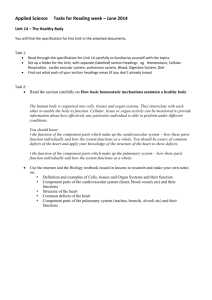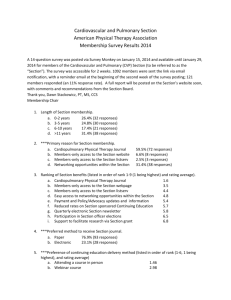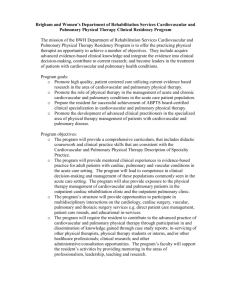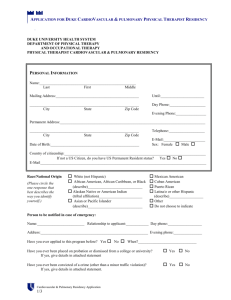Cardiovascular and Pumonary Form ()
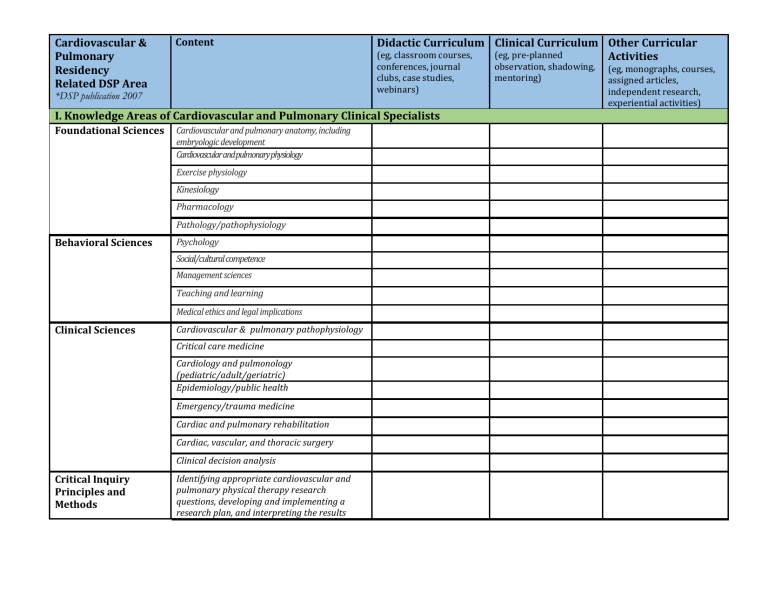
Cardiovascular &
Pulmonary
Residency
Related DSP Area
*DSP publication 2007
Content
Didactic Curriculum
(eg, classroom courses, conferences, journal clubs, case studies, webinars)
I. Knowledge Areas of Cardiovascular and Pulmonary Clinical Specialists
Foundational Sciences Cardiovascular and pulmonary anatomy, including embryologic development
Cardiovascular and pulmonary physiology
Exercise physiology
Behavioral Sciences
Kinesiology
Pharmacology
Pathology/pathophysiology
Psychology
Social/cultural competence
Management sciences
Teaching and learning
Clinical Sciences
Critical Inquiry
Principles and
Methods
Medical ethics and legal implications
Cardiovascular & pulmonary pathophysiology
Critical care medicine
Cardiology and pulmonology
(pediatric/adult/geriatric)
Epidemiology/public health
Emergency/trauma medicine
Cardiac and pulmonary rehabilitation
Cardiac, vascular, and thoracic surgery
Clinical decision analysis
Identifying appropriate cardiovascular and pulmonary physical therapy research questions, developing and implementing a research plan, and interpreting the results
Clinical Curriculum
(eg, pre-planned observation, shadowing, mentoring)
Other Curricular
Activities
(eg, monographs, courses, assigned articles, independent research, experiential activities)
The physical therapist practicing as a cardiovascular and pulmonary clinical specialist demonstrates advanced knowledge and skills in critical
inquiry by:
Developing appropriate methods to answer the research question, including identifying independent/dependent variables, population and sample characteristics, and necessary statistical analysis
Synthesizing the current theory/literature supporting the identified problem
Designing procedures and accurately collecting data necessary to answer a research question or to identify quality assurance indicators
Mentoring others in the collaborative investigation process
Disseminating results of research and collaborative investigation endeavors through presentations to peers, other health care professionals, and the public, as appropriate
II. Professional Roles, Responsibilities, and Values
Professional
Behaviors Reflecting the Core Values
The physical therapist practicing as a cardiovascular and pulmonary clinical specialist exhibits the following behaviors reflecting the core values of a professional
by:
Leadership
Effectively recognizing and resolving problems in difficult situations
Willingly devoting time and effort to resolve a complex problem
Recognizing when health care issues go beyond an individual level to the institutional and societal health care issues and tenaciously advocating for such issues
Demonstrating life-long learning through pursuit of advanced knowledge, skills, and abilities
Demonstrating leadership or active membership and involvement in professional organizations related to cardiovascular and pulmonary practice
Modeling prioritization in patient/client examination and intervention
The physical therapist practicing as a cardiovascular and pulmonary clinical specialist demonstrates leadership by:
Education Theory and
Practice
The physical therapist practicing as a cardiovascular and pulmonary clinical specialist demonstrates ability to educate others by demonstrating the ability to:
Administration
The physical therapist practicing as a cardiovascular and pulmonary clinical specialist demonstrates
Modeling professionalism and maturity in decision-making and interpersonal interactions
Seeking opportunities to mentor others
Identifying multiples strategies to resolve a problem
Facilitating conflict resolution by guiding others in identifying appropriate strategies
Using evidence-based practice to shape system policies and procedures, selecting the most effective method to build consensus
Participating in activities beyond his or her immediate scope of responsibility in order to expand, improve, or define the practice or awareness of cardiovascular and pulmonary physical therapy
Educate physical therapy students and other physical therapists, including other master clinicians, to increase knowledge and skills in cardiovascular and pulmonary physical therapy using educational approaches appropriate to the level of the learner
Provide interdisciplinary education to other health care professionals and outside agencies demonstrating mastery of cardiovascular and pulmonary physical therapy
Identifying the structure and function of the cardiovascular and pulmonary physical therapy practice in a given practice setting
Identifying the administrative needs of the cardiovascular and pulmonary practice, including priorities and resource availability
administrative ability by
effectively:
Consultation
The physical therapist practicing as a cardiovascular and pulmonary clinical specialist demonstrates consultation
through:
Evidence-Based
Developing and/or implementing sound cardiovascular and pulmonary physical therapy policies and procedures to meet the needs of the practice setting
Evaluating the effect of policies and procedures on the cardiovascular and pulmonary physical therapy practice
Addressing and resolving issues related to delivery of services, staff productivity, quality assurance, cost containment, and third-party reimbursement in cardiovascular and pulmonary physical therapy practice settings—including designing, collecting, and analyzing clinical outcomes related to cardiovascular and pulmonary physical therapy practice
Identifying and evaluating feasibility of individual, program, or regional project goals, including identification of discrepancies between the program status and the goals
Identifying his or her own and other health professionals’ available resources and potential contribution to the project
Developing and assessing the feasibility of alternative methods to meet goals
Assisting in selection and implementation of a method for attaining the project goals
Providing a second opinion regarding patient/client impairment, functional limitation, or disability status
Analyzing risk factors for cardiovascular or pulmonary dysfunction across practice settings
Identifying, synthesizing, and integrating current literature into clinical practice
Practice
The physical therapist practicing as a cardiovascular and pulmonary clinical specialist demonstrates evidence-based practice through:
Demonstrating leadership and skill through formal presentations that rely on the current literature related to cardiovascular and pulmonary physical therapy practice
Evaluating the efficacy and effectiveness of new and established examination tools, interventions, and technologies
Participating in clinical outcome data collection and interpretation
III. Patient/Client Management Expectations
Examination
(History)
Conducting a highly efficient, effective, and focused patient/client interview to anticipate and detect cardiovascular and/or pulmonary impairments by ascertaining such things as current/previous symptoms, physical and psychological lifestyle, environmental exposures, risk factor information, understanding of the cardiovascular and/or pulmonary disease and the related impairments, motivation for lifestyle change, and patient/family goals.
Reviewing and interpreting the clinical significance for physical therapy of all available patient/client data, including the
following:
Patient/client chief complaint, symptomatology, and goals for physical therapy
Medical, surgical, social, psychological, and family history, including health habits and risk factors for cardiovascular and pulmonary disease
Employment/work history
Functional status/living environment
General health status and physical examination findings
Examination
(Systems Review)
Examination
(Test and Measures)
Cardiovascular and pulmonary clinical tests, diagnostic studies, radiological studies, physiologic monitoring (including life support requirements and hemodynamic stability monitoring, eg, mechanical ventilators, intra-aortic balloon pumps, ventricular assist devices), and laboratory analysis
Medical interventions, including pharmacological interventions affecting the cardiovascular and pulmonary systems
Progress notes from other health care team members
Identifying and describing tools appropriate for screening the cardiovascular/pulmonary, musculoskeletal, neuromuscular, and integumentary systems for the population being tested
Applying tools in a timely and efficient manner, within the constraints of available equipment and environment, and with appropriate delegation
Observing the patient/client response, collects data in an appropriate manner, and assigns to patient/client appropriate classification
Recommending action(s) based on the results.
Possible actions include: decision to evaluate, referral to other providers, and no further intervention recommended
Selecting and prioritizing appropriate tests and measures based on the results of initial history and systems review examination
Prioritizing test selection based on scientific merit and clinical utility as determined by best available evidence
Evaluation
Performing clinical tests and measures such that data collection is accurate and precise, including the following:
Aerobic capacity/endurance/exercise – initial exam and reexamination o Independently conducting or assisting with maximum symptom-limited exercise tests using an ergometer, treadmill, or appropriate modality with or without metabolic measurements o Independently conducting submaximal exercise tests
Assessing cardiac pump function, differentiating patient-driven versus mechanical support (eg, ventricular assist device (VAD) parameters, pulmonary artery pressures)
Differentiating among impairments, functional limitations, disabilities, and risk factors that require compensatory strategies versus intervention strategies, focusing on recovery of normal movement
Linking impairments, functional limitations, disabilities, and psychosocial factors to the patient’s/client’s and caregiver’s expressed goals
Analyzing and interpreting observed physiological response to interventions in complex patients
Analyzing and interpreting the results of an exercise test to write an individual and specific exercise prescription
Diagnosis
Prognosis
Interventions
(Coordination,
Communication, and
Documentation)
Analyzing, interpreting, and recommending interventions in the presence of risk factors for cardiovascular and/or pulmonary disease
Recognizing and appropriately responding to potentially life-threatening changes in physiologic status
Integrating data from monitors, tests, screens, and evaluations used or performed by other health care professionals
Analyzing and interpreting data from the examination to develop a physical therapy differential diagnosis
Differentiating among impairments, functional limitations, disabilities, and risk factors that are responsive to intervention
Referring patient/client to other professionals for findings that are outside the scope of the physical therapist’s knowledge, experience, or expertise
Predicting optimal level of improvement in function, including time to achieve that level, with a high level of accuracy
Developing a plan of care that prioritizes interventions related to the recovery process, patient/client goals, resources, risk factors, health, and wellness
Indicating the plan of care is based on sound physiologic principles, the ability of the patient/client to participate and the resources available
Consulting and communicating regarding critical and potentially life-threatening conditions and changes in patient/client status to member(s) of the health care team in a timely and appropriate manner
Interventions
(Patient/Client-Related
Instruction)
Demonstrating leadership skills in cardiovascular and pulmonary specialty practice by leading patient rounds, conferences, and team meetings
Actively seeking to increase utilization of cardiovascular and pulmonary specialty services by referring practitioners
Implementing programs or services designed to prevent cardiovascular and pulmonary disease in collaboration with one or more of the following: patients, families, care providers, organizations, and the public
Providing consultation services to peer professionals in multiple practice settings regarding patients and clients with cardiovascular and pulmonary risk factors, impairments, functional limitations, and disabilities
Educating patient/clients about diagnosis, prognosis, treatment interventions, responsibility for health maintenance, and selfmanagement within plan of care—adeptly translating complex concepts into lay terms
Effectively instructing caregivers in therapeutic interventions that integrate specialty techniques (eg, airway clearance, suctioning, exercises) into the patient/client plan of care
Instructing patient/client in self-monitoring
(eg, pulse, blood pressure, pulse oximetry, dyspnea scale, perceived exertion scale, angina, claudication, or other pain scales) through therapeutic intervention and activities of daily living
Interventions
(Procedural
Interventions)
Specific Intervention
Techniques
(Therapeutic Exercise)
Instructing patient/client in functional activities and disability management that correspond appropriately to patient/client cardiovascular and pulmonary diagnosis/status and available resources and support system
Instructing patients/clients in health promotion and wellness, risk factor modification, screening for cardiovascular and pulmonary disease presence/progression or impairments, nutrition, energy conservation, and stress management
Consistently evaluating the result of instructional efforts by observing a learner’s ability to perform the skills that were taught and by responding to deficits
Modifying or continuing intervention based on on-going evaluation and best available evidence
Selecting and specifically prescribing or modifying interventions based on the patient’s/client’s anatomic and physiological changes across the lifespan and the current medical status/stability
Selecting and specifically prescribing or modifying interventions based on type and severity of the cardiovascular and pulmonary pathology, impairment, functional limitation, or disability
Negotiating barriers to interventions with the patient/client, including cognition, literacy, language, emotional state, socioeconomic status, and scarcity of resources, resulting in improved/optimized adherence
Prescription and performance of training techniques to improve strength or endurance of ventilatory muscles and to develop breathing retraining strategies
Specific Intervention
Techniques
(Airway Clearance
Techniques)
Prescription and performance of training methods for patients/clients using electrocardiogram (ECG), ventilatory volume/pattern, oximetry, and other monitoring devices to titrate intensity, duration, frequency, and need for supportive devices (eg, oxygen)
Appropriate prescription and performance of training methods for patients/clients with hemodynamic support/monitoring devices (eg, ventricular assist device [VAD], pulmonary arterial [PA] catheters, etc)
Utilization of mechanical ventilation methods to support physical therapy interventions (eg, bi-level positive airway pressure [BiPAP], positive pressure ventilator)
Appropriate prescription and performance of training techniques for patients/clients requiring cardiovascular assist devices (VAD, intraaortic balloon pump [IABP])
Prescribe therapeutic exercise interventions and appropriately implement and monitor responses of patients/clients on ventilatory assist devices (mechanical ventilators,
BiPAP/continuous positive airway pressure
[CPAP])
Perform nasotracheal suctioning
Perform endotracheal (via artificial airway, oral or tracheal) suctioning
Recommend, select, and appropriately manage oxygen delivery systems for purpose of treatment
Appropriately manage ventilatory support systems during physical therapy intervention and recommend the use of ventilatory support systems to maximize ventilation during functional movement
Outcomes
Provide manual ventilation during intervention
Perform assistive cough techniques—manual and mechanical
Recommend and appropriately manage mechanical airway clearance devices, such as high-frequency chest wall oscillators (eg,
Vest®), positive expiratory pressure (PEP) devices, and oscillating PEP (eg, Acapella®,
Flutter ®, intrapulmonary percussive ventilation)
Instruct and direct patient/client-driven and independent self-management intervention techniques, such as autogenic drainage, active cycle of breathing, and self-suctioning
Managing the patient/client with adverse responses to treatment, including basic cardiopulmonary resuscitation and advanced cardiac life support as state law allows
Using outcomes data to modify own future practice
